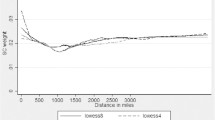Abstract
This study examines whether the low-skilled employment effects of minimum wage increases differ over the state business cycle. Controlling for spatial heterogeneity via state-specific productivity shocks to the low-skilled sector and state-specific non-linear time trends, the results suggest that minimum wage increases between 1989 and 2012 reduce low-skilled employment more during recessions than expansions. Estimated employment elasticities with respect to the minimum wage range from 0 to −0.2 during state economic expansions, but reach as high as −0.3 during troughs in the business cycle.
Similar content being viewed by others
Notes
For instance, the authors note that it is unclear how to conceptually interpret differences in estimates of low-skilled employment levels for the same county depending on the county-pair to which it is matched.
Along similar lines, Addison et al. (2013) find little evidence of heterogeneous effects of the minimum wage across the business cycle for restaurant or bar employment.
They find that this result holds even after controlling for state-specific linear time trends, but do not present estimates exploring the sensitivity to census division-specific year effects.
When the minimum wage changes mid-year, I construct the weighted average for the minimum wage that existed in that calendar year.
Note, however, that the inclusion of these GDP controls may understate employment effects of the minimum wage if minimum wage hikes reduce low-skilled GDP through adverse employment effects (Sabia 2011).
The employment elasticity during expansions is simply the coefficient on the log minimum wage variable.
These estimates are obtained by summing the coefficients on the minimum wage variable and the interaction of the minimum wage variable and an indicator variable for weak growth (<2 %) in real GDP generated by the finance industry.
When I estimate an ordered probit model of the effect of minimum wage increases on the prime-age male unemployment rate (including state and year effects), I find no evidence of a statistically significant relationship, with a point estimate of −0.949 and a standard error of 2.73. This finding holds with the inclusion of state-specific non-linear time trends (third-order polynomial time effects).
References
Addison JT, Blackburn MKL, Cotti CD (2009) Do minimum wages raise employment? Evidence from the US retail-trade sector. Labour Econ 16(4):397–408
Addison JT, Blackburn MK, Cotti C (2013) Minimum wage increases in a recessionary environment. Labour Econ 23:30–39
Allegretto SA, Dube A, Reich M (2011) Do minimum wages really reduce teen employment? Accounting for heterogeneity and selectivity in state panel data. Ind Relat 50(2):205–240
Baskaya YS, Rubinstein Y (2011) Using federal minimum wage effects to identify the impact of minimum wages on employment and earnings across U.S. States. Unpublished paper, Central Bank of Turkey
Bertrand M, Duflo E, Mullainathan S (2004) How much should we trust difference-in-difference estimates? Q J Econ 119:249–75
Burkhauser RV, Couch KA, Wittenburg DC (2000) A reassessment of the new economics of the minimum wage. J Labor Econ 18(4):653–81
Card D, Krueger AB (1995) Myth and measurement: the new economics of the minimum wage. Princeton University Press, Princeton
Deere D, Murphy KM, Welch F (1995) Reexamining methods of estimating minimum wage effects: Employment and the 1990–1991 minimum wage hike. Am Econ Assoc Pap Proc 85:232–237
Department of Labor (2013) “Changes in Basic Minimum Wages in Non-Farm Employment Under State Law: Selected Years 1968–2012.” Available at: http://www.dol.gov/whd/state/stateMinWageHis.htm
Dube A, William Lester T, Reich M (2010) Minimum wage effects across state borders: Estimates using contiguous counties. Rev Econ Stat 92(4):945–64
Neumark D, Wascher W (2007) Minimum wages and employment. Found Trends MicroEcon 3(1–2):1–182
Neumark D, Wascher W (2008) Minimum Wages. MIT Press, Cambridge
Neumark D, Salas JMI, Wascher W (2014) “Revisiting the minimum wage-employment debate: an evaluation of new evidence (Or, Be careful Not to Throw the Baby Out with the Bathwater),” Industrial and Labor Relations Review, Forthcoming
Reich M (2009) “Minimum wages in the united states: Politics, economics, and econometrics”, in labor in the Era of globalization, brown, eichengreen, and Reich eds. Cambridge University Press, Cambridge, pp 353–74
Sabia JJ (2009) Identifying minimum wage effects in state panels: Evidence from the current population survey. Ind Relat 48(2):311–28
Sabia JJ, Burkhauser RV, Hansen B (2012) Are the effects of minimum wage increases always small? New evidence from a case study of New York state. Ind Labor Relat Rev 65(2):350–376
Author information
Authors and Affiliations
Corresponding author
Appendixes
Appendixes
Appendixes 1
Appendixes 2
Appendixes 3
Appendixes 4
Rights and permissions
About this article
Cite this article
Sabia, J.J. The Effects of Minimum Wages over the Business Cycle. J Labor Res 35, 227–245 (2014). https://doi.org/10.1007/s12122-014-9180-x
Published:
Issue Date:
DOI: https://doi.org/10.1007/s12122-014-9180-x




